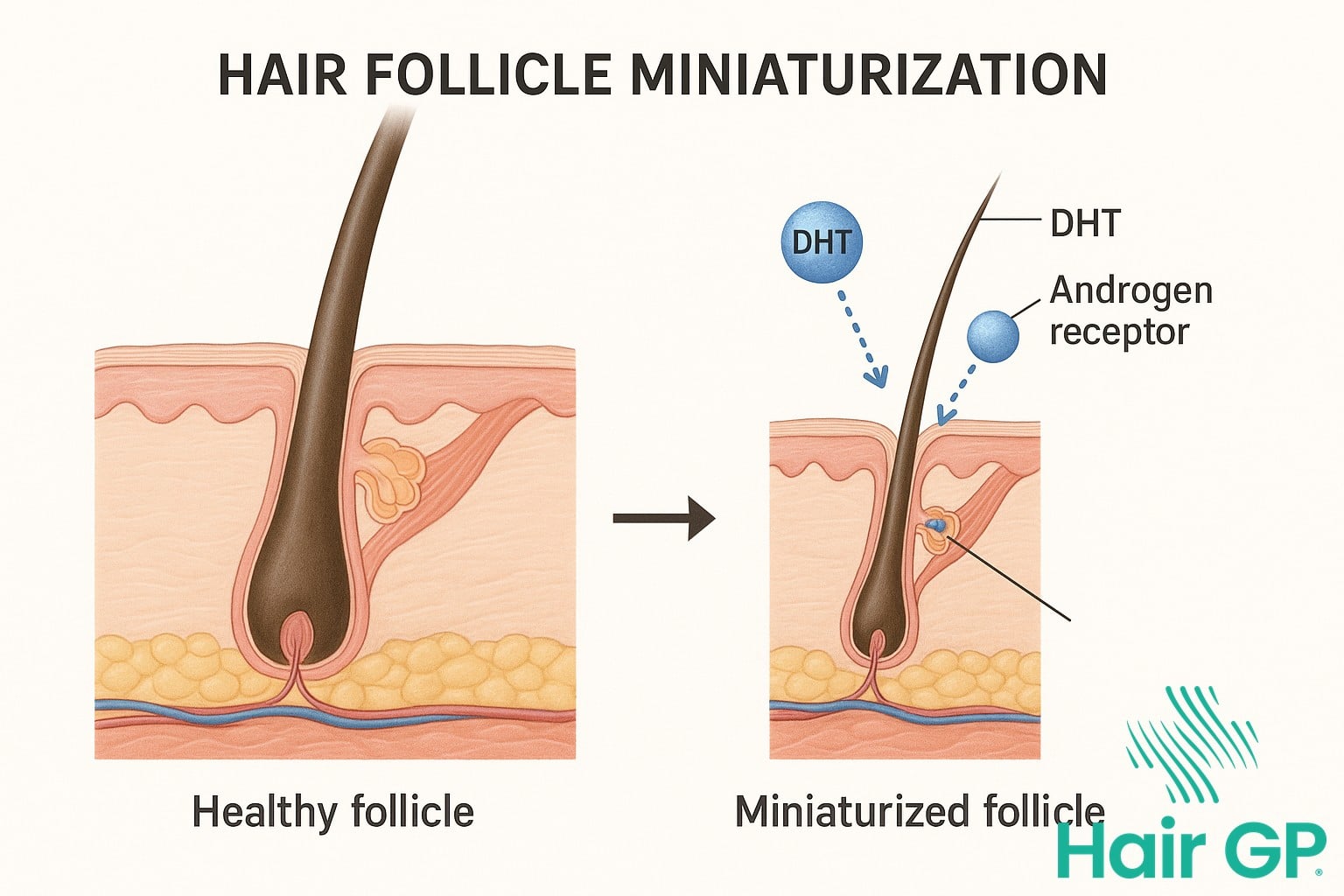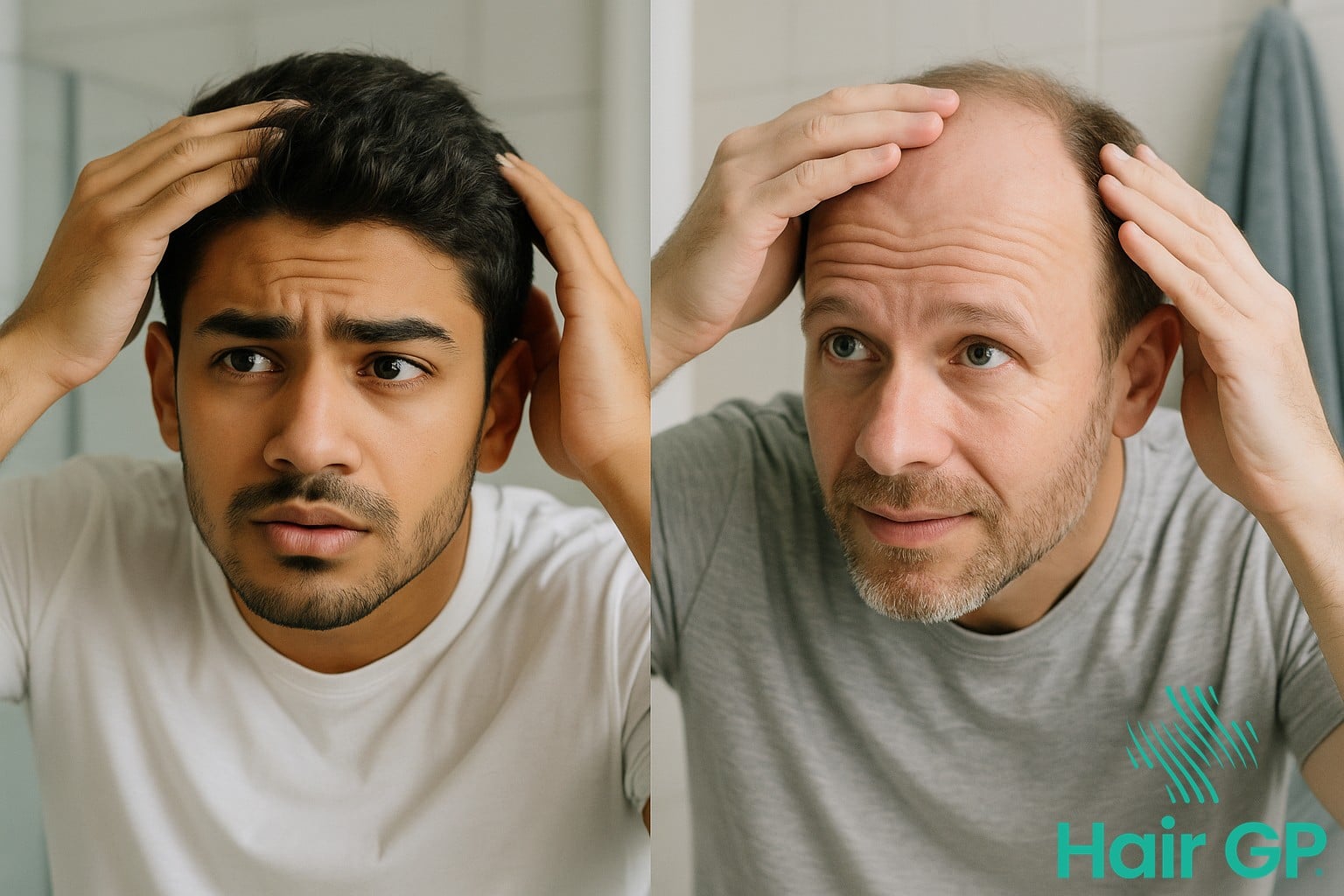Introduction
Creatine supplementation has become one of the most popular and extensively researched performance-enhancing supplements in the fitness world, trusted by millions of athletes and recreational gym-goers. However, a persistent concern continues to circulate within fitness communities: does creatine cause hair loss? This question has sparked countless debates and left many potential users hesitant to incorporate this otherwise beneficial supplement into their routines.
The controversy stems from a single study suggesting that creatine might increase levels of dihydrotestosterone (DHT), a hormone linked to male pattern baldness. This potential connection between DHT and hair loss has created widespread anxiety, particularly among men already predisposed to androgenetic alopecia. Yet, the relationship between creatine and hair health remains far more nuanced than many online discussions suggest.
This comprehensive analysis examines the scientific evidence surrounding creatine’s potential effects on hair loss, separating fact from fiction through careful evaluation of research data. We’ll explore the fundamental mechanisms of how creatine works in the body, investigate the theoretical connection to DHT production, and critically assess what studies actually demonstrate about this relationship. Additionally, we’ll identify individual risk factors that might influence susceptibility and provide practical, evidence-based recommendations for those considering or currently using creatine supplementation.
Whether you’re an athlete seeking performance benefits or someone concerned about maintaining healthy hair, this article provides the clarity needed to make informed decisions about creatine use based on current scientific understanding.
Key Takeaways – TL/DR
- Limited research suggests creatine may increase DHT levels, but evidence directly linking it to hair loss is inconclusive
- Only one small study from 2009 showed DHT increases, which has not been replicated in larger trials
- Individual genetic susceptibility to androgenetic alopecia plays a crucial role in any potential hair loss risk
- Millions use creatine safely without experiencing hair loss, suggesting the risk, if any, affects a small subset of users
- Monitoring your response and consulting healthcare providers can help make an informed decision about creatine use
What is Creatine and How Does It Work?
Creatine serves as a fundamental component in the body’s energy metabolism system, particularly crucial for high-intensity athletic performance and muscle function. Understanding how this naturally occurring compound works within skeletal muscle tissue is essential before examining any potential side effects, including concerns about hair loss.
Creatine’s Role in Energy Production
Creatine plays a vital role in the phosphocreatine (PCr) energy system, which provides rapid energy replenishment during high-intensity exercise. Within skeletal muscle cells, creatine combines with phosphate groups to form phosphocreatine, serving as a readily available energy reserve [1]. When muscles require immediate energy during explosive movements or resistance training, phosphocreatine rapidly donates its phosphate group to regenerate ATP (adenosine triphosphate), the body’s primary energy currency.
This ATP-PCr system is particularly crucial during the first 10-15 seconds of maximal effort, making creatine supplementation especially beneficial for activities requiring short bursts of power. Research indicates that approximately 40-50% of elite athletes regularly use creatine supplements to enhance their athletic performance [2], making it one of the most widely adopted supplements in sports nutrition.
Forms and Usage of Creatine Supplements
Creatine monohydrate remains the gold standard among various forms of creatine supplements, demonstrating consistent effectiveness and safety across numerous studies. Typical supplementation protocols involve either a loading phase (20g daily for 5-7 days) followed by maintenance (3-5g daily), or simply beginning with the maintenance dose. Both approaches effectively increase muscle creatine stores by 20-40%, leading to improvements in muscle mass, strength, and high-intensity exercise capacity. The supplement’s ability to enhance training volume and recovery makes it particularly valuable for athletes engaged in regular resistance training programmes.

The DHT Connection: Understanding the Theory
The theoretical link between creatine supplementation and hair loss centres on the potential elevation of dihydrotestosterone (DHT), a potent androgenic hormone derived from testosterone. This mechanism suggests that increased creatine intake might alter the DHT to testosterone ratio, potentially accelerating androgenetic alopecia in genetically predisposed individuals.
How DHT Affects Hair Follicles
Dihydrotestosterone plays a central role in male pattern baldness by binding to androgen receptors in susceptible hair follicles with five times greater affinity than testosterone [3]. This binding initiates a cascade of cellular changes leading to follicle miniaturisation, where terminal hairs progressively transform into vellus-like hairs. The process involves shortening of the anagen (growth) phase and prolongation of the telogen (resting) phase, ultimately resulting in thinner, shorter hairs.
Genetic susceptibility determines which follicles respond to DHT exposure, typically affecting the crown and frontal scalp regions whilst sparing the occipital area. Individuals with androgenetic alopecia possess hair follicles with increased androgen receptor density and enhanced 5-alpha reductase activity, the enzyme converting testosterone to DHT [4]. This genetic predisposition explains why some individuals experience significant hair loss whilst others remain unaffected despite similar hormone levels.
The 2009 Rugby Study: Origin of the Concern
The creatine-hair loss controversy originated from a 2009 study by van der Merwe and colleagues examining South African rugby players [5]. The research found that creatine supplementation increased DHT levels by 56% after a seven-day loading phase, maintaining a 40% elevation during the maintenance phase. However, this study had significant limitations: it included only 20 participants, lasted merely three weeks, and crucially, did not measure actual hair loss or follicle changes.
The study’s findings showed that whilst DHT increased, testosterone levels remained unchanged, altering the DHT to testosterone ratio. Normal ratios typically range from 1:10 to 1:20, and the creatine group’s ratios remained within physiological limits despite the increase. Most importantly, no subsequent studies have replicated these findings, leaving this singular research as the sole evidence linking creatine to elevated androgenic hormones.

Scientific Evidence: What Research Actually Shows
The relationship between creatine supplementation and hair loss remains a contentious topic in sports nutrition research, with limited scientific evidence examining direct connections between these variables. Current research primarily focuses on creatine’s effects on hormone levels, particularly dihydrotestosterone (DHT) and testosterone concentrations, rather than measuring actual hair loss outcomes in study participants.
Studies Supporting the DHT-Hair Loss Link
The primary scientific evidence linking creatine to potential hair loss originates from a 2009 study involving college rugby players in South Africa [5]. This randomised controlled trial examined hormonal responses to creatine supplementation over three weeks, comprising a seven-day loading phase followed by a fourteen-day maintenance phase. Researchers observed that DHT levels increased by 56% during the loading phase and remained elevated by 40% throughout the maintenance period [5].
Notably, whilst DHT increased significantly, total testosterone and free testosterone levels remained unchanged throughout the study period. This selective elevation of DHT without corresponding changes in testosterone concentrations suggests creatine might influence 5-alpha reductase activity, the enzyme responsible for converting testosterone to DHT. The study’s strengths included its controlled design and comprehensive hormone monitoring, though researchers did not assess actual hair loss or follicular changes in participants.
Contradictory Research and Limitations
Despite the 2009 study’s findings, subsequent research has failed to replicate these hormonal changes. Multiple studies examining creatine’s effects on testosterone and DHT levels have shown no significant alterations in hormone profiles [6]. A comprehensive review analysing twelve studies on creatine and testosterone found no consistent evidence of increased testosterone concentrations or DHT elevation across different populations and supplementation protocols [6].
Critical limitations undermine the hair loss hypothesis. No study has directly measured hair loss, follicle miniaturisation, or baldness progression in creatine users. The lack of replication studies specifically examining DHT responses represents a significant gap in the scientific evidence. Additionally, confounding variables such as training intensity, genetic predisposition, and dietary factors remain uncontrolled in most research. The 2009 study’s small sample size and short duration further limit its generalisability to long-term creatine users or diverse populations.

Risk Factors and Individual Susceptibility
Individual susceptibility to potential hair loss from creatine supplementation varies significantly based on genetic predisposition and lifestyle factors. Understanding these risk factors enables individuals to make informed decisions about supplement use whilst monitoring for early signs of hair thinning or changes in hair follicle health.
Genetic Predisposition to Hair Loss
Family history serves as the strongest predictor of male pattern baldness susceptibility. Individuals with close relatives experiencing alopecia demonstrate increased likelihood of developing similar patterns, particularly when baldness occurs on the maternal side. The androgen receptor gene, located on the X chromosome, determines follicular sensitivity to DHT. Variations in this gene influence how strongly hair follicles respond to circulating androgens, with some individuals possessing follicles that remain resistant despite elevated androgen levels.
Ethnic background also influences susceptibility patterns. Caucasian males typically experience higher rates of androgenetic alopecia compared to Asian or African populations, with approximately 50% of Caucasian men showing some degree of hair loss by age 50. These ethnic variations reflect differences in androgen receptor sensitivity and baseline DHT production.
Other Contributing Factors
Age significantly impacts vulnerability to DHT-related hair loss. Younger individuals generally possess more resilient follicles, whilst those over 30 may experience accelerated progression if predisposed. Baseline DHT levels vary considerably between individuals, with naturally elevated levels potentially amplifying any creatine-induced increases.
Concurrent supplement use requires careful consideration. Testosterone boosters, certain protein supplements, or compounds affecting hormone metabolism may interact with creatine’s potential DHT effects. Additionally, lifestyle factors including chronic stress, nutritional deficiencies, and scalp health influence overall follicular resilience. Regular assessment of hair density and recession patterns helps identify early changes, particularly for those with multiple risk factors.

Practical Recommendations for Creatine Users
Making informed decisions about creatine supplements requires balancing potential benefits for exercise and sports performance with individual concerns about side effects. This section provides evidence-based strategies for safe creatine monohydrate supplementation whilst monitoring for any unwanted effects, helping users maximise performance gains whilst minimising concerns.
Monitoring Your Response to Creatine
Before starting supplementation, establish a baseline hair assessment by taking clear photographs from multiple angles under consistent lighting. Document your hairline, crown, and overall density monthly to track any changes objectively. Most users experience water retention within the first week, whilst potential hair changes would typically appear after 3-6 months of consistent use.
Keep a supplement diary noting dosage, timing, and any observed effects including muscle cramping or other side effects. If you notice concerning changes, consider temporarily discontinuing use to determine whether creatine is the cause. Remember that normal hair shedding involves losing 50-100 hairs daily, so minor fluctuations shouldn’t cause alarm.
Alternative Supplementation Strategies
For those concerned about potential hair effects, consider starting with lower doses of 2-3 grams daily rather than the standard 5-gram protocol. This approach may reduce DHT elevation whilst still providing performance benefits. Cycling strategies, such as 8 weeks on followed by 4 weeks off, allow periodic hormonal normalisation.
If hair concerns persist, explore alternative performance enhancers. Beta-alanine improves muscular endurance without affecting hormones, whilst protein supplementation supports muscle growth through different mechanisms. Citrulline malate enhances blood flow and reduces fatigue, offering complementary benefits to training. These alternatives can be combined strategically to support athletic goals whilst avoiding concerns about hair loss, though they may not replicate creatine’s specific benefits for high-intensity performance.

Conclusion
The concern about creatine’s effect on hair loss stems from a single 2009 study that showed increased DHT levels in rugby players. However, the current scientific evidence does not definitively establish whether creatine contributes to hair loss in the general population. Sport science research has extensively documented the safety and efficacy of creatine supplementation, yet this specific concern remains inadequately investigated.
Individual responses to both creatine supplementation and hair loss vary significantly. Genetic predisposition to male pattern baldness, existing hormone levels, and overall health status all play crucial roles in determining outcomes. For those with a family history of hair loss, the theoretical DHT increase may warrant additional consideration, though concrete evidence remains elusive.
Making an informed decision requires weighing the well-established performance benefits against theoretical risks. Athletes and fitness enthusiasts should consider their personal risk factors, monitor any changes, and consult healthcare professionals if concerned. Until more comprehensive research emerges, the relationship between creatine and hair loss remains speculative. Those experiencing hair loss whilst using creatine should evaluate multiple contributing factors rather than attributing it solely to supplementation. Ultimately, individual circumstances should guide decisions about creatine use.
Frequently Asked Questions
Current research has not established that creatine causes permanent hair loss. The theoretical concern stems from one study showing increased DHT levels, but no studies have directly measured hair loss from creatine use. Any potential effects would likely be reversible upon discontinuation.
If creatine were to affect hair through DHT elevation, changes might theoretically begin within weeks to months. However, hair loss is a gradual process, and noticeable changes typically take 3-6 months. Most creatine users report no hair changes even with long-term use.
If you notice hair thinning while taking creatine, consider multiple factors including genetics, stress, nutrition, and other supplements. Consult a healthcare provider to determine the cause. You may try discontinuing creatine for 3-6 months to see if it makes a difference.
No research has compared different creatine forms regarding hair loss risk. The one study linking creatine to increased DHT used creatine monohydrate. Since the mechanism would theoretically be the same across forms, type likely doesn’t matter for this potential side effect.
Women have much lower DHT levels and different hair loss patterns than men. The theoretical DHT-related mechanism would be less relevant for women. No research has specifically examined creatine’s effects on female hair loss, but the risk appears minimal.
References
- Kreider RB, Kalman DS, Antonio J, et al. International Society of Sports Nutrition position stand: safety and efficacy of creatine supplementation in exercise, sport, and medicine. J Int Soc Sports Nutr. 2017;14:18.
- Maughan RJ, Burke LM, Dvorak J, et al. IOC consensus statement: dietary supplements and the high-performance athlete. Br J Sports Med. 2018;52(7):439-455.
- Randall VA, Thornton MJ, Hamada K, et al. Androgens and the hair follicle. Cultured human dermal papilla cells as a model system. Ann N Y Acad Sci. 1991;642:355-375.
- Kaufman KD. Androgens and alopecia. Mol Cell Endocrinol. 2002;198(1-2):89-95.
- van der Merwe J, Brooks NE, Myburgh KH. Three weeks of creatine monohydrate supplementation affects dihydrotestosterone to testosterone ratio in college-aged rugby players. Clin J Sport Med. 2009;19(5):399-404.
- Antonio J, Candow DG, Forbes SC, et al. Common questions and misconceptions about creatine supplementation: what does the scientific evidence really show? J Int Soc Sports Nutr. 2021;18(1):13.









